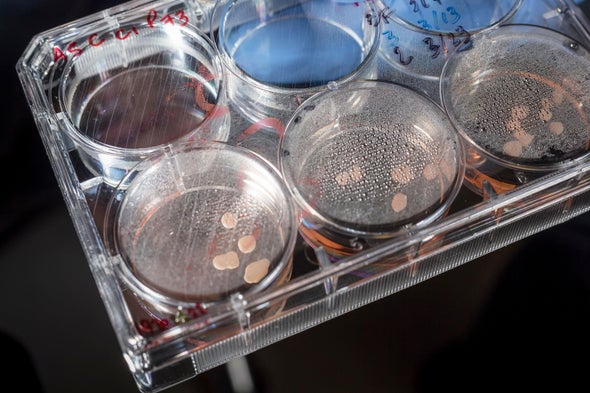(单词翻译:单击)
听力文本
This is Scientific American's 60-second Science, I'm Susanne Bard.
It's not easy to study the early development of the human brain.
"The brain is very inaccessible, especially the early fetal stages. It's just not ethical to study normal, healthy human brains."
University of California, San Diego, biologist Alysson Muotri. He says researchers have instead relied on animal models.
"But the human brain is so much different from other species that we're desperate to have, really, a human model so we can study the human brain."
Now Muotri's team may have that model, in the form of small globules of brain cells they've created in the lab. These pea-sized structures develop from stem cells that are bathed in a culture of nutrients, along with proteins that control gene activation. As the little structures grow, their constituents also specialize into different types of brain cells.
"And they will form connections, and these connections will form functional synapses that will, later on, turn into networks."
After two months, the mini brains even begin to emit brain waves.
"And you can record every week to see how the activity has changed. And when they reach about six months of age, we see a growth exponentially in the number of connections and synapses that they can make."
And at around 10 months, their brain activity compares to that of premature human infants.
"They're pretty much following the same trajectory as the human brain does."

That could make the mini brains very useful for understanding how our brains become wired early on. And they could also provide insights into the development of neurological conditions such as autism and epilepsy.
"These very early stages are exactly when some neurological conditions appear. And we have the possibility to help millions of people with neurological conditions."
But Muotri also cautions that as the technology moves forward, ethical questions will start to emerge.
"Someone might ask, 'Are they conscious or are they self-aware? Can they feel pain?' I think we are in a gray zone, where this technology could evolve to something more complex. And then I think the ethical question would be, 'What's the moral status of these miniaturized brains?'"
Muotri says that same question has formed the basis for the rules and regulations governing the use of animals in the lab, which can serve as a model to guide the mini brain research. The findings are in the journal Cell Stem Cell.
In addition to shedding light on neurological development, mini brains could also help reveal how the human brain evolved and play a role in improving algorithms for artificial intelligence. These pea-sized brains may produce some big insights.
Thanks for listening for Scientific American — 60-Second Science. I'm Susanne Bard.
参考译文
这里是科学美国人——60秒科学系列,我是苏珊娜·巴德。
研究人脑的早期发育并不容易。
“大脑很难进入,尤其是胎儿早期。研究正常健康的人脑是不道德的。”
加州大学圣地亚哥分校的生物学家阿里森·穆特里说到。他表示,研究人员转而依赖动物模型。
“但人脑与其他物种的大脑存在相当大的区别,因此我们迫切需要人类模型来研究人脑。”
现在,穆特里的团队可能拥有了这种模型,其形式是他们在实验室中创造出来的脑细胞小球。这些豌豆大小的结构由干细胞发育而来,而这些干细胞浸泡在营养物质和控制基因激活的蛋白质培养物中。随着这些小结构的成长,其成分也会分化成不同类型的脑细胞。
“它们会形成连接,这些连接会形成功能性突触,突触随后会联成网络。”
两个月后,微型大脑甚至会开始释放脑电波。
“你可以每周进行记录,观察活动变化。当它们长到约6个月大时,其能形成的连接和突触数量呈指数级增长。”
在大约 10个月大的时候,其大脑活动与早产儿类似。
“微型大脑的发育轨道与人脑非常相似。”
这可能使微型大脑非常有助于理解人脑早期的连接形式。微型大脑还可以为自闭症和癫痫等神经系统疾病的发展提供思路。
“神经疾病往往出现在大脑发育非常早期的阶段。我们有可能帮助数百万名神经疾病患者。”
但穆特里也警告称,随着技术的进步,伦理问题将开始显现。
“有人可能会问,‘这些大脑有意识吗?或它们有自我意识吗?它们能感受到疼痛吗?’我认为我们处于技术可进化出更复杂事物的灰色地带。之后的伦理问题将是,‘这些微型大脑的道德地位如何?’”
穆特里表示,同样的问题构成了在实验室使用动物的规章制度的基础,而这可以作为引导微型大脑研究的范例。研究结果发表在《细胞·干细胞》期刊上。
除了阐释神经发育,微型大脑还有助于揭示人类大脑的进化方式,并在改善人工智能算法方面发挥作用。这些豌豆大小的大脑可能会催生一些重大的见解。
谢谢大家收听科学美国人——60秒科学。我是苏珊娜·巴德。
译文为可可英语翻译,未经授权请勿转载!
重点讲解
重点讲解:
1. rely on 依赖;依靠;
Most poultry farmers have to rely on commercially manufactured feeds.
多数饲养家禽的农场主不得不依赖商业化生产的饲料。
2. be desperate to do sth. 极需要的;渴望的;
They are desperate to erase the memory of that last defeat in Cardiff.
他们急于抹去上次在卡迪夫遭遇失败的记忆。
3. serve as 用作;可当…使用;充作;
The Ambassador said he hoped the statement would serve as a wake-up call to the government.
大使说,他希望这一声明能给政府敲响警钟。
4. shed light on 使(某事)显得非常清楚;使人了解(某事);
A new approach offers an answer, and may shed light on an even bigger question.
新的方法提供了一个答案,并且可能让人们对一个更大的问题有进一步的了解。


